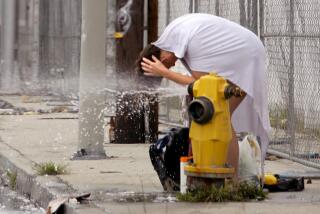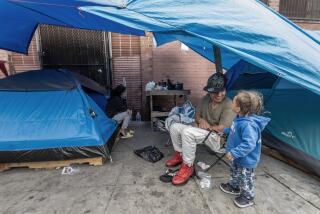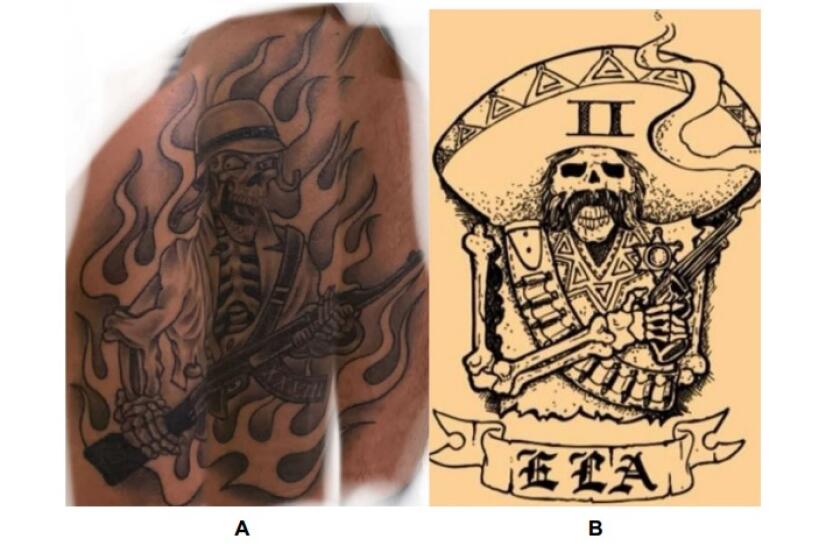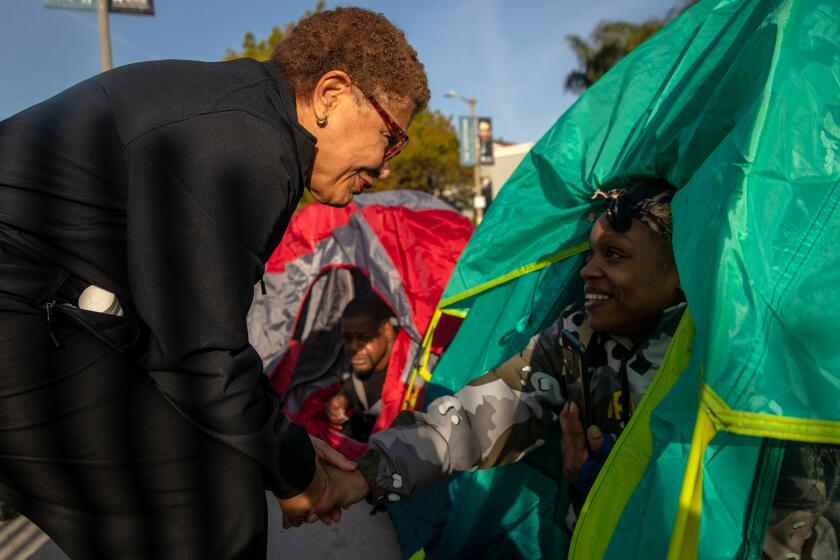Persistent strain of TB claims victims on L.A.’s skid row
Public health officials have launched a new, coordinated attack to contain a persistent outbreak of tuberculosis on downtown Los Angeles’ skid row, including a search for more than 4,500 people who may have been exposed to the disease.
The Centers for Disease Control and Prevention has dispatched scientists to Los Angeles to help local health officials determine why the disease is spreading and how to stop it.
Officials say 11 have died since 2007. Sixty of the 78 cases were among homeless people who live on and around skid row.
Scientists have recently linked the outbreak to a tuberculosis strain that is unique to Los Angeles, with a few isolated cases outside the area.
“This is the largest outbreak in a decade,” said Jonathan Fielding, director of the Los Angeles County Department of Public Health. “We are really putting all of our resources into this.”
Health workers have identified about 4,650 people who were probably exposed and are trying to track them down for testing and treatment. Local and federal officials are particularly concerned because the cases are linked to one relatively small geographic area and one vulnerable population. But officials are concerned that the outbreak could spread beyond skid row if action isn’t taken.
Homeless people are especially at risk of getting TB and of being undiagnosed because they have poor hygiene and nutrition, limited access to healthcare and ongoing contact with infected people. Transmission of the airborne disease is also common because the homeless live in overcrowded areas and are constantly moving among hospitals, shelters and the streets. Many homeless people also have substance abuse or mental health issues that can impede treatment.
“They go from place to place and the likelihood of passing it along is much greater,” said Paul Gregerson, chief medical officer of the JWCH Institute, which runs a homeless healthcare program on skid row. “It makes everybody more susceptible.”
Tuberculosis is easily transmitted by inhaling droplets from infected patients when they sneeze, cough or laugh. When left untreated, TB can be deadly. The skid row strain can be treated with all anti-TB medications. Treatment lasts six to nine months.
The public health department issued an alert several weeks ago to doctors at emergency rooms, clinics and urgent care centers informing them about the investigation within the homeless community.
Most of the patients are men and about 20% are also HIV-positive, according to the alert, which was obtained by The Times. Six of the eight patients who also had HIV have died.
The increase of TB among the homeless population is occurring even as the county is seeing a decline in overall cases, officials said. There are probably additional cases among the homeless population that have not yet been confirmed.
The health department also issued new guidelines for shelters earlier this year on how to effectively screen and identify patients at risk of tuberculosis. The guidelines urge shelters to appoint a TB liaison and to create a “cough alert” log for tracking patients with persistent coughs.
The county also recommended that shelters determine if incoming clients have been screened and refer those who haven’t been to health providers.
The county suggests that all employees and volunteers also be screened for TB because they are also at risk.
As part of the ongoing investigation, the public health department asked shelters last week for information about everybody who has used their services. In the Feb. 12 letter, Los Angeles County TB Control Program acting Director Peter Kerndt said that the information “is necessary to investigate the increase in TB cases so that appropriate steps can be taken to prevent and control the spread.”
Officials at local shelters said they are committed to working with public health officials.
“We’re trying to understand the urgency of what the CDC and L.A. County Health is doing,” Midnight Mission spokeswoman Mai Lee said.
“It does raise questions and concerns.”
At the Union Rescue Mission’s health clinic, officials said they are taking a much more proactive approach to TB screening — going to the patients rather than waiting for them to come to the clinic.
Mary Marfisee, medical director of the UCLA School of Nursing Health Center, said teams of students began searching the area this week for people who are most at risk.
“We are testing everybody who is willing to be tested,” she said. “And those who aren’t willing, we are trying to talk them into it.”
Union Rescue Mission Chief Executive Andy Bales added that his staff members are ensuring that any clients with a cough are sent immediately to the clinic for evaluation.
Standing in the courtyard of the Midnight Mission on Thursday, Fred Christopher said he gets tested regularly for tuberculosis but is concerned about symptoms among other homeless people he comes into contact with.
“There’s a good deal of people out here who don’t care whether they get [a TB test] or not and there’s people who do care but take their time about caring, like putting off their doctor’s appointment for later,” Christopher said.
Christopher, who has been living on the streets since 2005, said he has seen people “coughing like crazy.”
Carol Oakman-Schmid, 54, who is also homeless, said she has heard people at the shelter with coughs that come from “way down deep in their chest.”
“Whether it’s TB, I don’t know, I’m not a doctor,” she said. “But sure it’s a concern, absolutely. You have a lot of respiratory ailments here.”
More to Read
Sign up for Essential California
The most important California stories and recommendations in your inbox every morning.
You may occasionally receive promotional content from the Los Angeles Times.










